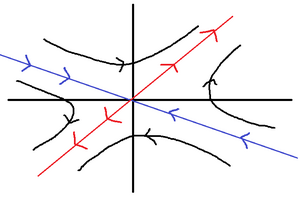Science:Math Exam Resources/Courses/MATH215/December 2013/Question 05 (a)
{{#incat:MER QGQ flag|{{#incat:MER QGH flag|{{#incat:MER QGS flag|}}}}}}
• Q1 (a) • Q1 (b) • Q1 (c) • Q1 (d) • Q1 (e) • Q1 (f) • Q2 (a) • Q2 (b) • Q3 (a) • Q3 (b) • Q4 (a) • Q4 (b) • Q4 (c) • Q5 (a) • Q5 (b) • Q6 (a) • Q6 (b) • Q6 (c) • Q7 (a) • Q7 (b) • Q7 (c) •
Question 05 (a) |
|---|
|
Find the general solution of the homogeneous linear system and sketch the phase portrait (i.e. some typical trajectories in the plane). |
|
Make sure you understand the problem fully: What is the question asking you to do? Are there specific conditions or constraints that you should take note of? How will you know if your answer is correct from your work only? Can you rephrase the question in your own words in a way that makes sense to you? |
|
If you are stuck, check the hint below. Consider it for a while. Does it give you a new idea on how to approach the problem? If so, try it! |
Hint |
|---|
|
A good start would be to find the eigenvalues and eigenvectors. This way you can see how the solution trajectories behave (growing/shrinking) in different directions. |
|
Checking a solution serves two purposes: helping you if, after having used the hint, you still are stuck on the problem; or if you have solved the problem and would like to check your work.
|
Solution |
|---|
|
We begin by finding the eigenvalues and eigenvectors. The characteristic polynomial of is which has roots . The find the eigenvector with eigenvalue , we seek the nullspace of . With , we have: From the equation implied by the first row (the second is redundant), so we can take . With , we have:
From the equation implied by the first row (the second is the same), so we can take as an eigenvector. The general solution is . The origin is a saddle point because the eigenvalues are real and of opposite sign. Along the direction, the solution grows exponentially. Along the direction, the solution decays exponentially. At all other points, it will approach the line spanned by as . This is displayed in the figure. |
{{#incat:MER CT flag||
}}
![{\displaystyle {\vec {x}}(t)=\left[{\begin{array}{c}x(t)\\y(t)\end{array}}\right]}](https://wiki.ubc.ca/api/rest_v1/media/math/render/svg/3ae55d9e446ed599f82ac2616d227b89ea96051d)
![{\displaystyle {\vec {x}}'=A{\vec {x}},\qquad A=\left[{\begin{array}{cc}0&3\\2&1\end{array}}\right],}](https://wiki.ubc.ca/api/rest_v1/media/math/render/svg/7ab3a95c523912633360341a4d88e32a8e0f6a82)



















